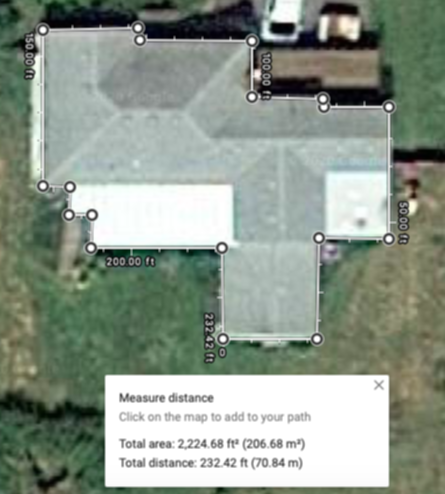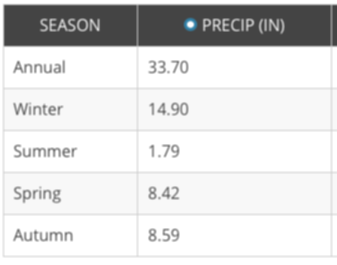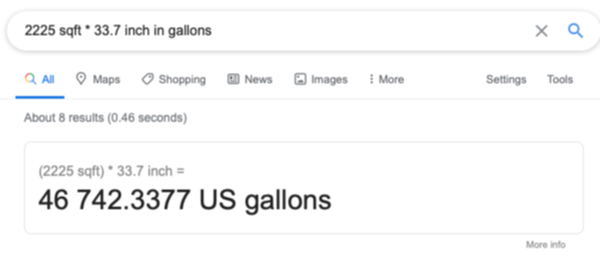This week I was working with a friend to find good size water barrels for their house, and the question came up, “How much rainwater could we collect in a year?” So, I thought I would share with you today, the easy way to figure out just how much could be collected on your roof in a year (or month). No measuring!
How to calculate how much rainwater you could collect. A roof will collect 62.3 gallons of water per 100 ft of area covered by the roof per inch of rainfall. But, how much area does your roof cover? Use the relatively unknown distance measure tool in Google Maps to find out super quickly.
Below, I’ll show you exactly how to go through this process step by step. It is much faster and more accurate than measuring the roof directly, or using any of those online rainwater calculators. I also have a simple trick to make the calculations a breeze, even easier than a calculator!
How to Measure Rainwater Collection Water Potential
Knowing how much water you could potentially collect from your roof is essential to properly sizing your rainwater collection system, and knowing what you are able to do with it. This method below, I haven’t seen anyone else describe before, and it is the quickest and most accurate method I have found to date.
Step 1 — Use Google Maps to Find Out Your Roof Area
Type in your address or otherwise find your land on Google Maps. If you haven’t already, switch the view mode to satellite photos, so you can see your house on the map. Zoom in until the house is a good size on the screen.
Then, right click on corner of the build your are measuring, and choose “Measure Distance” from the menu the pops up.

Now continue clicking on each corner around the house until you get all the way back around, then click on the first point again to close the outline.
If you make a mistake, you can always drag the points to be better aligned with the photo. Clicking a point without moving will delete that point. And, clicking a line will add a point there, which you can move around as necessary.

Once you have the points in place, you can read your roof’s square footage directly from the bottom of the screen.
Note that this should not be the same as the amount of roofing you would need to cover a roof (unless your roof is flat). And, it is not the same as the square footage of your home. It is the area that your roof actually covers.
Step 2 — Look Up the Average Rainfall in Your Area
Historical rainfall records are kept by the NOAA in the United States. Go to the linked website to look up your annual, seasonal, or monthly rainfall averages.
On the page, click tab “Annual/Seasonal Normals”, and below that select the state and then city or airport weather station closest to your location. This will give you a table that shows weather facts including average rainfall (precipitation) in inches.

If you want to find out how much total water you could collect in a year, write down or remember the yearly average in inches, the first line on the table.
Usually, you will need to size your cisterns to get you through the driest part of the year. To help estimate how much water you will get through each season, you can run the calculations in step 3 with seasonal average rainfalls in the rows after.
For a more granular monthly view, choose the “Monthly Normals” tab, which shows you a monthly table and a monthly average rainfall.
Step 3 — Multiply to Find Gallons of Water
Lastly, calculate how many gallons of water your roof will collect, by multiplying the average rainfall by the roof area, and converting to appropriate units. They easy way to do this is with the hidden calculator built in to Google search.
Typing calculations in to google with their dimensions in inches and feet (or meter and centimeters) etc will automatically do proper conversions. You can select which units come out saying by adding “in gallons” for example (or “in liters”).
For example, the area and rainfall shown above can be typed in as:
2225 sqft * 33.7 inch in gallonsThis is what the results look like when running it through Google:

This result shows that for the house in the example, the roof will produce on average 47,000 gallons a year.
You could also calculate the average rainfall for each season or month by substituting in the appropriate rainfall in inches (instead of the 33.7 figure).
More info on rainwater collection:
How Much Rainwater Storage Do I Need?
Most people only need enough rainwater storage to get them through the dry season, or to offset their needs during the summer. In general, you will not need enough rainwater storage to collect an entire year’s supply worth of water.
To estimate how much water you need, start by estimating your monthly usage at different times of the year. For most people, you will use more water in the heat of the summer than in the winter, but that depends on how you intend to use your water. If you are only irrigating with rainwater, then you will only need water during the growing season. And, the amount of water used depends on your climate, crop, and field size.
Then, take a look at the monthly totals on thee NOAA weather database for your area, and find the longest range of months that produce less water in your system than you would be consuming during the month. For instance, in my area we don’t get any rain for four months in the summer, and very little in the months before and after. Therefore, I would need to store 5–6 months worth of water to cover that season.
For those of you where it rains in the summer, you won’t have to store as much water, so calculate how much water you will get during the dry months, and subtract that from your total usage during that time to determine how much rainwater storage you need.
How to Store Rainwater
Rainwater is best stored in a tank or cistern. There are a number of options available depending on the size that you need.
For relatively small tanks, less than 1,000 gallons, poly-plastic tanks are the lowest cost, and come in either above ground or below ground varieties.
Pre-fabricated metal tanks are available in both galvanized steel and stainless steel. For tank over about 1,000 gallons, galvanized steel tanks are the lowest cost per gallon stored, but require a plastic liner to function correctly. For those conscious of having their water stored in plastic, stainless steel is a great option although relatively expensive.
If you interested in a lower cost DIY option, then look in to ferrocement, which is a form of cement construction that doesn’t require expensive and time consuming forms to pour liquid cement in to. Rather, you plaster thicker cement on to a pre-constructed steel core.
There isn’t much online about the ferrocement method, although it is widely used throughout the world. Here is how to guide on ferrocement to get you started:
Related Questions
How many gallons of water can I collect from my roof?
A roof will collect 62.3 gallons of water per 100 sqft of area covered by the roof per inch of rainfall. How much, if any, of the water you can store for later use depends on your state, but most states allow collecting some or all of the water. Some cities even offer incentives for rainwater collection.
How quickly does a rain barrel fill up?
A rain barrel will raise one inch for every inch of rain. A rain barrel collecting from a roof will store 62.3 gallons per 100 iqt of roof per inch of rain. Overall, the rate that your rain barrel fills depends on how much rain you get and how big of a roof you have.
How do you collect large amounts of rainwater?
In order to collect large amounts of rainwater, you need access to a large roof or surface to collect water from. For every 100 sqft of space you are collecting on, you will get 62.3 gallons of water per inch of rain. You will also need a large cistern to store your rainwater.


